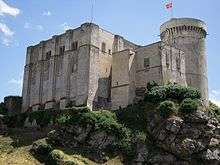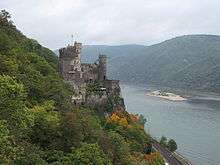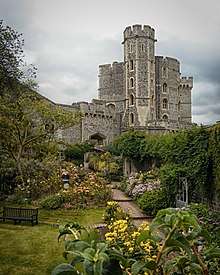Castles
Castles are fortified residences built in Europe, the Middle East and Japan during the Middle Ages by nobility or monarchies and by military orders.
Understand
While both fortifications and stately homes have been known since ancient times, the combination of those functions arose in Europe around AD 900, as strongholds of local feudal lords.
Castles went through many stages of development, to respond to military and economic needs.
The adoption of gunpowder weapons from the 14th to the 17th centuries made castles gradually less useful as fortifications, and replaced by bastion forts. The style with towers and battlements remained for decoration of palaces and grand houses well into the 19th century.
Europe
France

- 🌍 Château Guillaume-le-Conquérant de Falaise, ☎ +33 2 31 41 61 44, fax: +33 2 31 41 66 87. The, Place Guillaume le Conquérant, open Feb—Dec 10AM-6PM (closes 7PM Jul and Aug), NB: closed 8 Jan—9 Feb inclusive and Christmas Day, admission adults €6.50, concessions and students €5, children 6-16 €3 - William the Conquerer's birthplace and an important stronghold of the Dukes of Normandy and English kings until the French king Phillipe Augustus wrested the castle from the hands of King John in 1204. The castle remains an impressive example of Norman fortification. Excellent audio-visual displays. English guided tours available (phone ahead). Castle shop.
Germany

Germany has an abundance of castles as the medieval period saw a vast amount of small and tiny polities gaining de facto independence and there were several low ranking noblemen who had their own castle as a defense in case of (frequent) feuds or a safe haven from which to strike trade routes and the likes. The 13th century with the almost total collapse of central authority in the Holy Roman Empire saw a high point in feuding but even after feuds were largely eliminated and legal recourse for disputes was established new castles were constructed for various defensive and - increasingly - representative purposes.
- 🌍 Marksburg, ☎ +49 2627 536. Medieval castle above the town. Probably one of the best preserved in Germany as it was never successfully taken. Open to the public.
- 🌍 Burgruine Streitburg. This ruined castle is on a hill right next to the hill Neideck stands on (see below) "Streit" means "quarrel" in German and the tale goes that the two neighboring castles had a quarrel with each other leading to the destruction of both. The actual history doesn't confirm that tale but locals like to tell it regardless.
- 🌍 Burgruine Neideck. Right next to Streitburg on a neighboring hill, this castle ("Neid" means envy) is said to have fallen victim to the same quarrel as Streitburg although, again, the actual history was different.
- 🌍 Nuremberg Castle. Dating in its earliest parts to around the year 1000, this castle was at times an important residence for the Emperor when he traveled around his realm. Later the castle became a major symbol of the independent Freie Reichsstadt that was only subject to the emperor (and that only in theory) and it remains to this day a symbol of the largest city in Franconia.
United Kingdom

True Castles (those built for defensive purposes) in the United Kingdom were constructed from the start of Norman Conquest onward, until the early 17th century when developments in military technology rendered them less effective from a defensive viewpoint. Sometimes the castles were built on or near the basis of early pre-Norman fortifications.
Whilst there are true castles in Scotland (notably Edinbrugh and Stirling), there are also a number of tower-houses (effectively fortified residences).
- 🌍 Caernarfon Castle (Carnarvon Castle), Castle Ditch, LL55 2AY, ☎ +44 1286 677617. opens 0930 (except Su in winter 1100), closes 1600 winter, 1700 spring / autumn, 1800 summer, last admission half an hour before closing, closed 24-26 Dec, 1 Jan. (Welsh: Castell Caernarfon). An impressive work began in 1283 by England's King Edward I as his planned seat of power in his attempt to subjugate Wales. Like Beaumaris, this castle was quite functional, although never 100% completed. Notable use of this castle has included the investiture of a Princes of Wales on at least two occasions. admission £4.90, concessions £4.50, family £15.
- 🌍 Windsor Castle, Windsor, SL4 1NJ. 0945-1500 daily. Originally built by William the Conqueror following the Norman invasion in the 11th century, the castle has been used by the British royal family since the reign of King Henry I. Currently the largest inhabited castle in the world and used by the Queen as her primary weekend residence, though the state rooms are open to the public when not in use for state ceremonies. £21.20 adults, £19.30 seniors over 60, £12.30 children under 17.
Middle East
East Asia
China
Although China does not have a tradition of castle-building per se, the Forbidden City is surrounded by fortifications, making it resemble a castle in this respect.
Japan

While different in style from their European counterparts, Japan was also a nation of castle builders during the feudal period from the start of the Kamakura Period (12th century) to the end of the Azuchi-Momoyama Period (17th century). Unlike most surviving European castles, the main keeps (天守閣 tenshukaku) of Japanese castles were largely made of wood, so many have either decomposed or been lost to fire over the years. In addition, unlike in Europe, the main keep of the castle was a purely military structure and not the lord's residence, and there was typically a separate set of palace buildings next to the main keep to serve that purpose.
- 🌍 Nijo Castle (二条城), 〒604-8301 Kyoto Prefecture, Kyoto, Nakagyo Ward, Nijojocho, 541 (Kyoto Subway Nijojo-mae sation), ☎ +81 75 841 0096, fax: +81 75 802 6181. 0845-1600 Wed-Mon, closed Tue and 29-31 Dec. Served as the Tokugawa Shogun's residence whenever he was visiting the emperor in Kyoto, and a UNESCO World Heritage Site. Not classified as an original castle as the main keep was burnt down in a fire in 1750, but the outer fortifications and main palace buildings survive. Famous for its "nightingale floors", which were deliberately designed to squeak when someone walks on them so the Shogun and his guards could be alerted to any potential assassins. ¥600 adults, ¥200 students up to high school.
- 🌍 Himeji Castle (姫路城), 〒670-0012 Hyōgo Prefecture, Himeji, Honmachi, 68 (JR Himeji station), ☎ +81 79 285 1146, fax: +81 79 222 6050. 0900-1600 daily,. The only original Japanese castle to have been declared a UNESCO World Heritage Site to date, known for its white keep. Although the main keep is the original one, the palace buildings that served as the lord's residence have not survived. ¥1,000 adults, ¥300 children under 18.
See also
- Fortifications -
- Grand and Great houses - chateux, stately home, manor house, Schloss, Resedenz, palace